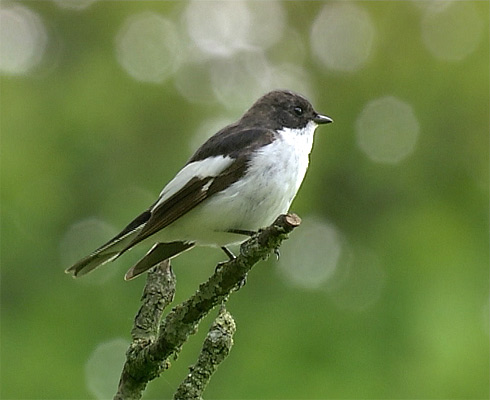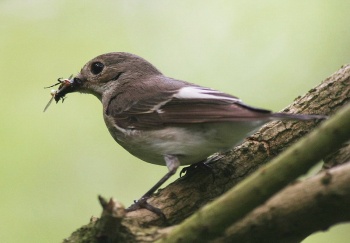m (→External Links: updated VSearch) |
|||
| (14 intermediate revisions by 6 users not shown) | |||
| Line 1: | Line 1: | ||
| − | + | [[Image:European_Pied_Flycatcher.jpg|thumb|550px|right|Male<br />Photo by {{user|Rob|Rob}}<br />Vaasse, [[The Netherlands]], May 2003]] | |
| − | + | ;[[:Category:Ficedula|Ficedula]] hypoleuca | |
| − | [[Image:European_Pied_Flycatcher.jpg|thumb|550px|right|Photo by Rob]] | ||
| − | |||
==Identification== | ==Identification== | ||
| − | + | 12-13 cm<br /> | |
| + | *Large white wing patches | ||
| + | *White Underparts | ||
| + | *White outer tail feathers | ||
| + | '''Breeding Male''' | ||
| + | *Black upperparts | ||
| + | *White forehead | ||
| + | '''Adult Female''': olive-brown above and lacks white forehead | ||
| + | ====Confusion Species==== | ||
| + | [[Collared Flycatcher]], [[Semicollared Flycatcher]], [[Atlas Flycatcher]]. | ||
| + | [[Image:IMG 69402.jpg|thumb|350px|right|Female<br />Photo by {{user|Chrysophylax|Chrysophylax}}<br />Dimmingsdale, [[UK]] June 2009]] | ||
==Distribution== | ==Distribution== | ||
| − | The most widespread and numerous of the three "pied" flycatchers of the Region. Breeds throughout most of Scandinavia and in mainland Europe from the Netherlands, Belgium and eastern France east to the Urals. Also breeds in parts of north and west Britain, at scattered sites in central and southern France, in central Iberia and in North-West Africa. | + | The most widespread and numerous of the three "pied" flycatchers of the Region. Breeds throughout most of [[Scandinavia]] and in mainland [[Europe]] from the [[Netherlands]], [[Belgium]] and eastern [[France]] east to the Urals. Also breeds in parts of north and west Britain, at scattered sites in central and southern France, in central Iberia and in North-West [[Africa]]. |
Migratory, leaving breeding areas in mid August-September to winter in West Africa and returns in mid April-June. Passage birds occur throughout most of Europe, the Middle East and North Africa. Occasional winter records from around the Mediterranean. | Migratory, leaving breeding areas in mid August-September to winter in West Africa and returns in mid April-June. Passage birds occur throughout most of Europe, the Middle East and North Africa. Occasional winter records from around the Mediterranean. | ||
| − | Vagrants recorded north to Svalbard, Iceland and Faroes, also Madeira and the Cape Verde Islands. | + | Vagrants recorded north to [[Svalbard]], [[Iceland]] and [[Faroes]], also Madeira and the [[Cape Verde Islands]]. |
==Taxonomy== | ==Taxonomy== | ||
| + | ====Subspecies==== | ||
| + | Three to four subspecies usually recognized<sup>[[#References|[1]]]</sup>: | ||
| + | * ''F. h. hypoleuca'': | ||
| + | :*[[British Isles]] and northern [[Europe]] to western [[Siberia]]; winters to tropical [[Africa]] | ||
| + | * ''F. h. iberiae'': male has slightly larger white forehead patch | ||
| + | :*Iberian Peninsula; winters in west [[Africa]] (not accepted by all authorities) | ||
| + | * ''F. h. sibirica (syn. tomensis)'': usually greyer than nominate but grey or brown individuals also occur commonly in Europe. <sup>[[#References|[2]]]</sup> | ||
| + | :*Taiga of western [[Siberia]] (Ural Mountains to Yenisey River); winters to eastern [[Africa]] | ||
| + | |||
| + | [[Atlas Flycatcher]] has formerly been considered a subspecies of this species. | ||
| + | |||
| + | <gallery> | ||
| + | Image:Pajarillo.jpg|Subspecies ''iberiae''<br />Photo by {{user|Nunu|Nunu}}<br />El Escorial, Madrid, [[Spain]], May 2009 | ||
| + | Image:Flycatcher 6788 900.jpg|Photo by {{user|Victor+Tyakht|Victor Tyakht}}<br />near Moscow, [[Russia]], June 2008 | ||
| + | </gallery> | ||
==Habitat== | ==Habitat== | ||
Preferred habitat is mature deciduous woodland, especially oak, but also found in mixed and coniferous woodland in upland areas in south of range. Occurs in orchards and parks, sometimes large gardens and often in areas of scrub on passage. | Preferred habitat is mature deciduous woodland, especially oak, but also found in mixed and coniferous woodland in upland areas in south of range. Occurs in orchards and parks, sometimes large gardens and often in areas of scrub on passage. | ||
==Behaviour== | ==Behaviour== | ||
| − | == | + | ====Breeding==== |
| + | They nest in a tree hole; 4-10 eggs are laid. They readily take to nest boxes. | ||
| + | ====Diet==== | ||
| + | The diet includes insects which are aerially hawked. | ||
| + | ====Vocalisation==== | ||
| + | {{ Audio|Ficedula hypoleuca (song).mp3 }} | ||
| + | ==References== | ||
| + | #{{Ref-Clements6thAug14}}#Avibase | ||
| + | #Collins Pocket Guide to British Birds 1966 | ||
| + | #Wikipedia | ||
| + | {{ref}} | ||
| + | ==External Links== | ||
| + | {{GSearch|"Ficedula hypoleuca" {{!}} "European Pied Flycatcher"}} | ||
| + | <br /> | ||
| + | {{VSearch|"Ficedula hypoleuca" {{!}} "European Pied Flycatcher", video}} | ||
| + | {{GS-checked}}1 | ||
| + | <br /> | ||
| + | <br /> | ||
| − | + | [[Category:Birds]][[Category:Ficedula]][[Category:Bird Songs]] [[Category:Videos]] | |
| − | |||
| − | |||
| − | |||
| − | |||
| − | |||
| − | [[Category: | ||
Revision as of 19:47, 12 June 2023
- Ficedula hypoleuca
Identification
12-13 cm
- Large white wing patches
- White Underparts
- White outer tail feathers
Breeding Male
- Black upperparts
- White forehead
Adult Female: olive-brown above and lacks white forehead
Confusion Species
Collared Flycatcher, Semicollared Flycatcher, Atlas Flycatcher.
Distribution
The most widespread and numerous of the three "pied" flycatchers of the Region. Breeds throughout most of Scandinavia and in mainland Europe from the Netherlands, Belgium and eastern France east to the Urals. Also breeds in parts of north and west Britain, at scattered sites in central and southern France, in central Iberia and in North-West Africa.
Migratory, leaving breeding areas in mid August-September to winter in West Africa and returns in mid April-June. Passage birds occur throughout most of Europe, the Middle East and North Africa. Occasional winter records from around the Mediterranean.
Vagrants recorded north to Svalbard, Iceland and Faroes, also Madeira and the Cape Verde Islands.
Taxonomy
Subspecies
Three to four subspecies usually recognized[1]:
- F. h. hypoleuca:
- British Isles and northern Europe to western Siberia; winters to tropical Africa
- F. h. iberiae: male has slightly larger white forehead patch
- Iberian Peninsula; winters in west Africa (not accepted by all authorities)
- F. h. sibirica (syn. tomensis): usually greyer than nominate but grey or brown individuals also occur commonly in Europe. [2]
Atlas Flycatcher has formerly been considered a subspecies of this species.
Photo by Victor Tyakht
near Moscow, Russia, June 2008
Habitat
Preferred habitat is mature deciduous woodland, especially oak, but also found in mixed and coniferous woodland in upland areas in south of range. Occurs in orchards and parks, sometimes large gardens and often in areas of scrub on passage.
Behaviour
Breeding
They nest in a tree hole; 4-10 eggs are laid. They readily take to nest boxes.
Diet
The diet includes insects which are aerially hawked.
Vocalisation
References
- Clements, J. F., T. S. Schulenberg, M. J. Iliff, D. Roberson, T. A. Fredericks, B. L. Sullivan, and C. L. Wood. 2014. The eBird/Clements checklist of birds of the world: Version 6.9., with updates to August 2014. Downloaded from http://www.birds.cornell.edu/clementschecklist/download/
- Avibase
- Collins Pocket Guide to British Birds 1966
- Wikipedia
Recommended Citation
- BirdForum Opus contributors. (2025) European Pied Flycatcher. In: BirdForum, the forum for wild birds and birding. Retrieved 11 May 2025 from https://www.birdforum.net/opus/European_Pied_Flycatcher
External Links
GSearch checked for 2020 platform.1







